Asia
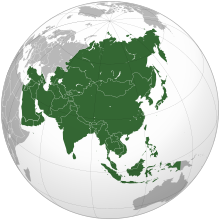 | |
| Area | 44,579,000 km2 (17,212,000 sq mi) (1st)[1] |
|---|---|
| Population | 4,560,667,108 (2018; 1st)[2][3] |
| Population density | 100/km2 (260/sq mi) |
| GDP (PPP) | $63.35 trillion (2021 est; 1st)[4] |
| GDP (nominal) | $34.39 trillion (2021 est; 1st)[5] |
| GDP per capita | $7,850 (2021 est; 4th)[6] |
| Demonym | Asian |
| Countries | 49 UN members, 1 UN observer, 5 other states |
| Dependencies | show
List |
| Non-UN states | show
List |
| Languages | List of languages |
| Time zones | UTC+2 to UTC+12 |
| Internet TLD | .asia |
| Largest cities |
|
| UN M49 code | 142 – Asia001 – World |

Asia (/ˈeɪʒə, ˈeɪʃə/ (![]() listen)) is Earth's largest and most populous continent, located primarily in the Eastern and Northern Hemispheres. It shares the continental landmass of Eurasia with the continent of Europe and the continental landmass of Afro-Eurasia with both Europe and Africa. Asia covers an area of 44,579,000 square kilometres (17,212,000 sq mi), about 30% of Earth's total land area and 8.7% of the Earth's total surface area. The continent, which has long been home to the majority of the human population,[7] was the site of many of the first civilizations. Its 4.5 billion people (as of June 2019) constitute roughly 60% of the world's population.[8]
listen)) is Earth's largest and most populous continent, located primarily in the Eastern and Northern Hemispheres. It shares the continental landmass of Eurasia with the continent of Europe and the continental landmass of Afro-Eurasia with both Europe and Africa. Asia covers an area of 44,579,000 square kilometres (17,212,000 sq mi), about 30% of Earth's total land area and 8.7% of the Earth's total surface area. The continent, which has long been home to the majority of the human population,[7] was the site of many of the first civilizations. Its 4.5 billion people (as of June 2019) constitute roughly 60% of the world's population.[8]
In general terms, Asia is bounded on the east by the Pacific Ocean, on the south by the Indian Ocean, and on the north by the Arctic Ocean. The border of Asia with Europe is a historical and cultural construct, as there is no clear physical and geographical separation between them. It is somewhat arbitrary and has moved since its first conception in classical antiquity. The division of Eurasia into two continents reflects East–West cultural, linguistic, and ethnic differences, some of which vary on a spectrum rather than with a sharp dividing line. The most commonly accepted boundaries place Asia to the east of the Suez Canal separating it from Africa; and to the east of the Turkish Straits, the Ural Mountains and Ural River, and to the south of the Caucasus Mountains and the Caspian and Black Seas, separating it from Europe.[9]
China and India alternated in being the largest economies in the world from 1 to 1800 CE. China was a major economic power and attracted many to the east,[10][11][12] and for many the legendary wealth and prosperity of the ancient culture of India personified Asia,[13] attracting European commerce, exploration and colonialism. The accidental discovery of a trans-Atlantic route from Europe to America by Columbus while in search for a route to India demonstrates this deep fascination. The Silk Road became the main east–west trading route in the Asian hinterlands while the Straits of Malacca stood as a major sea route. Asia has exhibited economic dynamism (particularly East Asia) as well as robust population growth during the 20th century, but overall population growth has since fallen.[14] Asia was the birthplace of most of the world's mainstream religions including Hinduism, Zoroastrianism, Judaism, Jainism, Buddhism, Confucianism, Taoism, Christianity, Islam, Sikhism, as well as many other religions.
Given its size and diversity, the concept of Asia—a name dating back to classical antiquity—may actually have more to do with human geography than physical geography.[citation needed] Asia varies greatly across and within its regions with regard to ethnic groups, cultures, environments, economics, historical ties and government systems. It also has a mix of many different climates ranging from the equatorial south via the hot desert in the Middle East, temperate areas in the east and the continental centre to vast subarctic and polar areas in Siberia.
Definition and boundaries
Asia–Africa boundary
The boundary between Asia and Africa is the Red Sea, the Gulf of Suez, and the Suez Canal.[15] This makes Egypt a transcontinental country, with the Sinai peninsula in Asia and the remainder of the country in Africa.
Asia–Europe boundary
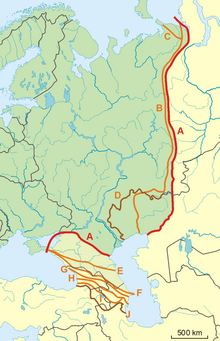
The threefold division of the Old World into Europe, Asia and Africa has been in use since the 6th century BC, due to Greek geographers such as Anaximander and Hecataeus.[citation needed] Anaximander placed the boundary between Asia and Europe along the Phasis River (the modern Rioni river) in Georgia of Caucasus (from its mouth by Poti on the Black Sea coast, through the Surami Pass and along the Kura River to the Caspian Sea), a convention still followed by Herodotus in the 5th century BC.[16] During the Hellenistic period,[17] this convention was revised, and the boundary between Europe and Asia was now considered to be the Tanais (the modern Don River). This is the convention used by Roman era authors such as Posidonius,[18] Strabo[19] and Ptolemy.[20]
The border between Asia and Europe was historically defined by European academics.[21] The Don River became unsatisfactory to northern Europeans when Peter the Great, king of the Tsardom of Russia, defeating rival claims of Sweden and the Ottoman Empire to the eastern lands, and armed resistance by the tribes of Siberia, synthesized a new Russian Empire extending to the Ural Mountains and beyond, founded in 1721. The major geographical theorist of the empire was a former Swedish prisoner-of-war, taken at the Battle of Poltava in 1709 and assigned to Tobolsk, where he associated with Peter's Siberian official, Vasily Tatishchev, and was allowed freedom to conduct geographical and anthropological studies in preparation for a future book.[citation needed]
In Sweden, five years after Peter's death, in 1730 Philip Johan von Strahlenberg published a new atlas proposing the Ural Mountains as the border of Asia. Tatishchev announced that he had proposed the idea to von Strahlenberg. The latter had suggested the Emba River as the lower boundary. Over the next century various proposals were made until the Ural River prevailed in the mid-19th century. The border had been moved perforce from the Black Sea to the Caspian Sea into which the Ural River projects.[22] The border between the Black Sea and the Caspian is usually placed along the crest of the Caucasus Mountains, although it is sometimes placed further north.[21]
Asia–Oceania boundary
The border between Asia and the region of Oceania is usually placed somewhere in the Malay Archipelago. The Maluku Islands in Indonesia are often considered to lie on the border of southeast Asia, with New Guinea, to the east of the islands, being wholly part of Oceania. The terms Southeast Asia and Oceania, devised in the 19th century, have had several vastly different geographic meanings since their inception. The chief factor in determining which islands of the Malay Archipelago are Asian has been the location of the colonial possessions of the various empires there (not all European). Lewis and Wigen assert, "The narrowing of 'Southeast Asia' to its present boundaries was thus a gradual process."[23]
Ongoing definition

Geographical Asia is a cultural artifact of European conceptions of the world, beginning with the Ancient Greeks, being imposed onto other cultures, an imprecise concept causing endemic contention about what it means. Asia does not exactly correspond to the cultural borders of its various types of constituents.[24]
From the time of Herodotus a minority of geographers have rejected the three-continent system (Europe, Africa, Asia) on the grounds that there is no substantial physical separation between them.[25] For example, Sir Barry Cunliffe, the emeritus professor of European archeology at Oxford, argues that Europe has been geographically and culturally merely "the western excrescence of the continent of Asia".[26]
Geographically, Asia is the major eastern constituent of the continent of Eurasia with Europe being a northwestern peninsula of the landmass. Asia, Europe and Africa make up a single continuous landmass—Afro-Eurasia (except for the Suez Canal)—and share a common continental shelf. Almost all of Europe and a major part of Asia sit atop the Eurasian Plate, adjoined on the south by the Arabian and Indian Plate and with the easternmost part of Siberia (east of the Chersky Range) on the North American Plate.
Etymology

The idea of a place called "Asia" was originally a concept of Greek civilization,[27] though this might not correspond to the entire continent currently known by that name. The English word comes from Latin literature, where it has the same form, "Asia". Whether "Asia" in other languages comes from Latin of the Roman Empire is much less certain, and the ultimate source of the Latin word is uncertain, though several theories have been published. One of the first classical writers to use Asia as a name of the whole continent was Pliny.[28] This metonymical change in meaning is common and can be observed in some other geographical names, such as Scandinavia (from Scania).
Bronze Age
Before Greek poetry, the Aegean Sea area was in a Greek Dark Age, at the beginning of which syllabic writing was lost and alphabetic writing had not begun. Prior to then in the Bronze Age the records of the Assyrian Empire, the Hittite Empire and the various Mycenaean states of Greece mention a region undoubtedly Asia, certainly in Anatolia, including if not identical to Lydia. These records are administrative and do not include poetry.
The Mycenaean states were destroyed about 1200 BCE by unknown agents, though one school of thought assigns the Dorian invasion to this time. The burning of the palaces caused the clay tablets holding the Mycenaean administrative records to be preserved by baking. These tablets were written in a Greek syllabic script called Linear B. This script was deciphered by a number of interested parties, most notably by a young World War II cryptographer, Michael Ventris, subsequently assisted by the scholar, John Chadwick.
A major cache discovered by Carl Blegen at the site of ancient Pylos included hundreds of male and female names formed by different methods. Some of these are of women held in servitude (as study of the society implied by the content reveals). They were used in trades, such as cloth-making, and usually came with children. The epithet lawiaiai, "captives", associated with some of them identifies their origin. Some are ethnic names. One in particular, aswiai, identifies "women of Asia".[29] Perhaps they were captured in Asia, but some others, Milatiai, appear to have been of Miletus, a Greek colony, which would not have been raided for slaves by Greeks. Chadwick suggests that the names record the locations where these foreign women were purchased.[30] The name is also in the singular, Aswia, which refers both to the name of a country and to a female from there. There is a masculine form, aswios. This Aswia appears to have been a remnant of a region known to the Hittites as Assuwa, centered on Lydia, or "Roman Asia". This name, Assuwa, has been suggested as the origin for the name of the continent "Asia".[31] The Assuwa league was a confederation of states in western Anatolia, defeated by the Hittites under Tudhaliya I around 1400 BCE.
Alternatively, the etymology of the term may be from the Akkadian word (w)aṣû(m), which means 'to go outside' or 'to ascend', referring to the direction of the sun at sunrise in the Middle East and also likely connected with the Phoenician word asa meaning 'east'. This may be contrasted to a similar etymology proposed for Europe, as being from Akkadian erēbu(m) 'to enter' or 'set' (of the sun).
T.R. Reid supports this alternative etymology, noting that the ancient Greek name must have derived from asu, meaning 'east' in Assyrian (ereb for Europe meaning 'west').[27] The ideas of Occidental (form Latin occidens 'setting') and Oriental (from Latin oriens for 'rising') are also European invention, synonymous with Western and Eastern.[27] Reid further emphasizes that it explains the Western point of view of placing all the peoples and cultures of Asia into a single classification, almost as if there were a need for setting the distinction between Western and Eastern civilizations on the Eurasian continent.[27] and Tenshin Okakura are two outspoken Japanese figures on the subject.[27]
Classical antiquity
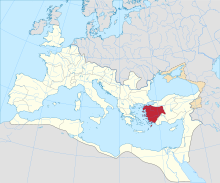
Latin Asia and Greek Ἀσία appear to be the same word. Roman authors translated Ἀσία as Asia. The Romans named a province Asia, located in western Anatolia (in modern-day Turkey). There was an Asia Minor and an Asia Major located in modern-day Iraq. As the earliest evidence of the name is Greek, it is likely circumstantially that Asia came from Ἀσία, but ancient transitions, due to the lack of literary contexts, are difficult to catch in the act. The most likely vehicles were the ancient geographers and historians, such as Herodotus, who were all Greek. Ancient Greek certainly evidences early and rich uses of the name.[32]
The first continental use of Asia is attributed to Herodotus (about 440 BCE), not because he innovated it, but because his Histories are the earliest surviving prose to describe it in any detail. He defines it carefully,[33] mentioning the previous geographers whom he had read, but whose works are now missing. By it he means Anatolia and the Persian Empire, in contrast to Greece and Egypt.
Herodotus comments that he is puzzled as to why three women's names were "given to a tract which is in reality one" (Europa, Asia, and Libya, referring to Africa), stating that most Greeks assumed that Asia was named after the wife of Prometheus (i.e. Hesione), but that the Lydians say it was named after Asies, son of Cotys, who passed the name on to a tribe at Sardis.[34] In Greek mythology, "Asia" (Ἀσία) or "Asie" (Ἀσίη) was the name of a "Nymph or Titan goddess of Lydia".[35]
In ancient Greek religion, places were under the care of female divinities, parallel to guardian angels. The poets detailed their doings and generations in allegoric language salted with entertaining stories, which subsequently playwrights transformed into classical Greek drama and became "Greek mythology". For example, Hesiod mentions the daughters of Tethys and Ocean, among whom are a "holy company", "who with the Lord Apollo and the Rivers have youths in their keeping".[36] Many of these are geographic: Doris, Rhodea, Europa, Asia. Hesiod explains:[37]
For there are three-thousand neat-ankled daughters of Ocean who are dispersed far and wide, and in every place alike serve the earth and the deep waters.
The Iliad (attributed by the ancient Greeks to Homer) mentions two Phrygians (the tribe that replaced the Luvians in Lydia) in the Trojan War named Asios (an adjective meaning "Asian");[38] and also a marsh or lowland containing a marsh in Lydia as ασιος.[39] According to many Muslims, the term came from Ancient Egypt's Queen Asiya, the adoptive mother of Moses.[40]
History
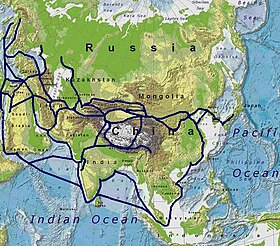

The history of Asia can be seen as the distinct histories of several peripheral coastal regions: East Asia, South Asia, Southeast Asia and the Middle East, linked by the interior mass of the Central Asian steppes. The coastal periphery was home to some of the world's earliest known civilizations, each of them developing around fertile river valleys. The civilizations in Mesopotamia, the Indus Valley and the Yellow River shared many similarities. These civilizations may well have exchanged technologies and ideas such as mathematics and the wheel. Other innovations, such as writing, seem to have been developed individually in each area. Cities, states and empires developed in these lowlands.
The central steppe region had long been inhabited by horse-mounted nomads who could reach all areas of Asia from the steppes. The earliest postulated expansion out of the steppe is that of the Indo-Europeans, who spread their languages into the Middle East, South Asia, and the borders of China, where the Tocharians resided. The northernmost part of Asia, including much of Siberia, was largely inaccessible to the steppe nomads, owing to the dense forests, climate and tundra. These areas remained very sparsely populated.
The center and the peripheries were mostly kept separated by mountains and deserts. The Caucasus and Himalaya mountains and the Karakum and Gobi deserts formed barriers that the steppe horsemen could cross only with difficulty. While the urban city dwellers were more advanced technologically and socially, in many cases they could do little in a military aspect to defend against the mounted hordes of the steppe. However, the lowlands did not have enough open grasslands to support a large horsebound force; for this and other reasons, the nomads who conquered states in China, India, and the Middle East often found themselves adapting to the local, more affluent societies.
The Islamic Caliphate's defeats of the Byzantine and Persian empires led to West Asia and southern parts of Central Asia and western parts of South Asia under its control during its conquests of the 7th century. The Mongol Empire conquered a large part of Asia in the 13th century, an area extending from China to Europe. Before the Mongol invasion, Song dynasty reportedly had approximately 120 million citizens; the 1300 census which followed the invasion reported roughly 60 million people.[42]
The Black Death, one of the most devastating pandemics in human history, is thought to have originated in the arid plains of central Asia, where it then travelled along the Silk Road.[43]
The Russian Empire began to expand into Asia from the 17th century, and would eventually take control of all of Siberia and most of Central Asia by the end of the 19th century. The Ottoman Empire controlled Anatolia, most of the Middle East, North Africa and the Balkans from the mid 16th century onwards. In the 17th century, the Manchu conquered China and established the Qing dynasty. The Islamic Mughal Empire and the Hindu Maratha Empire controlled much of India in the 16th and 18th centuries respectively.[44] The Empire of Japan controlled most of East Asia and much of Southeast Asia, New Guinea and the Pacific islands until the end of World War II.

The threefold division of the Old World into Europe, Asia and Africa has been in use since the 6th century BC, due to Greek geographers such as Anaximander and Hecataeus.

1825 map of Asia by Sidney Edwards Morse.

Map of western, southern, and central Asia in 1885[45]

The map of Asia in 1796, which also included the continent of Australia (then known as New Holland).

1890 map of Asia
Geography and climate
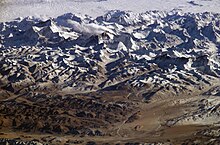
Asia is the largest continent on Earth. It covers 9% of the Earth's total surface area (or 30% of its land area), and has the longest coastline, at 62,800 kilometres (39,022 mi). Asia is generally defined as comprising the eastern four-fifths of Eurasia. It is located to the east of the Suez Canal and the Ural Mountains, and south of the Caucasus Mountains (or the Kuma–Manych Depression) and the Caspian and Black Seas.[9][46] It is bounded on the east by the Pacific Ocean, on the south by the Indian Ocean and on the north by the Arctic Ocean. Asia is subdivided into 49 countries, five of them (Georgia, Azerbaijan, Russia, Kazakhstan and Turkey) are transcontinental countries lying partly in Europe. Geographically, Russia is partly in Asia, but is considered a European nation, both culturally and politically.
The Gobi Desert is in Mongolia and the Arabian Desert stretches across much of the Middle East. The Yangtze River in China is the longest river in the continent. The Himalayas between Nepal and China is the tallest mountain range in the world. Tropical rainforests stretch across much of southern Asia and coniferous and deciduous forests lie farther north.

Mongolian steppe

Altai Mountains

Hunza Valley
Atolls of the Maldives

Wadi Rum in Jordan
Main regions

- North Asia
- Central Asia
- Western Asia (Near East)
- South Asia
- East Asia (Far East)
- Southeast Asia
There are various approaches to the regional division of Asia. The following subdivision into regions is used, among others, by the UN statistics agency UNSD. This division of Asia into regions by the United Nations is done solely for statistical reasons and does not imply any assumption about political or other affiliations of countries and territories.[47]
- North Asia (Siberia)[a]
- Central Asia (The 'stans)
- Western Asia (The Middle East or Near East)
- South Asia (Indian subcontinent)
- East Asia (Far East)
- Southeast Asia (East Indies and Indochina)
Climate
Asia has extremely diverse climate features. Climates range from arctic and subarctic in Siberia to tropical in southern India and Southeast Asia. It is moist across southeast sections, and dry across much of the interior. Some of the largest daily temperature ranges on Earth occur in western sections of Asia. The monsoon circulation dominates across southern and eastern sections, due to the presence of the Himalayas forcing the formation of a thermal low which draws in moisture during the summer. Southwestern sections of the continent are hot. Siberia is one of the coldest places in the Northern Hemisphere, and can act as a source of arctic air masses for North America. The most active place on Earth for tropical cyclone activity lies northeast of the Philippines and south of Japan.
A survey carried out in 2010 by global risk analysis farm Maplecroft identified 16 countries that are extremely vulnerable to climate change. Each nation's vulnerability was calculated using 42 socio, economic and environmental indicators, which identified the likely climate change impacts during the next 30 years. The Asian countries of Bangladesh, India, the Philippines, Vietnam, Thailand, Pakistan, China and Sri Lanka were among the 16 countries facing extreme risk from climate change.[48][49][50] Some shifts are already occurring. For example, in tropical parts of India with a semi-arid climate, the temperature increased by 0.4 °C between 1901 and 2003. A 2013 study by the International Crops Research Institute for the Semi-Arid Tropics (ICRISAT) aimed to find science-based, pro-poor approaches and techniques that would enable Asia's agricultural systems to cope with climate change, while benefitting poor and vulnerable farmers. The study's recommendations ranged from improving the use of climate information in local planning and strengthening weather-based agro-advisory services, to stimulating diversification of rural household incomes and providing incentives to farmers to adopt natural resource conservation measures to enhance forest cover, replenish groundwater and use renewable energy.[51]
The ten countries of the Association of Southeast Asian Nations (ASEAN) - Brunei, Cambodia, Indonesia, Laos, Malaysia, Myanmar, the Philippines, Singapore, Thailand, and Vietnam - are among the most vulnerable to the effects of climate change in the world, however, ASEAN's climate mitigation efforts are not commensurate with the climate threats and risks it faces.[52]
Economy

Asia has the largest continental economy by both GDP Nominal and PPP in the world, and is the fastest growing economic region.[53] As of 2018, the largest economies in Asia are China, Japan, India, South Korea, Indonesia and Turkey based on GDP in both nominal and PPP.[54] Based on Global Office Locations 2011, Asia dominated the office locations with 4 of the top 5 being in Asia: Hong Kong, Singapore, Tokyo and Seoul. Around 68 percent of international firms have an office in Hong Kong.[55]
In the late 1990s and early 2000s, the economies of China[56] and India have been growing rapidly, both with an average annual growth rate of more than 8%. Other recent very-high-growth nations in Asia include Israel, Malaysia, Indonesia, Bangladesh, Thailand, Vietnam, and the Philippines, and mineral-rich nations such as Kazakhstan, Turkmenistan, Iran, Brunei, the United Arab Emirates, Qatar, Kuwait, Saudi Arabia, Bahrain and Oman.
According to economic historian Angus Maddison in his book The World Economy: A Millennial Perspective, India had the world's largest economy during 0 BCE and 1000 BCE. Historically, India was the largest economy in the world for most of the two millennia from the 1st until 19th century, contributing 25% of the world's industrial output.[57][58][59][60] China was the largest and most advanced economy on earth for much of recorded history and shared the mantle with India.[61][62][63] For several decades in the late twentieth century Japan was the largest economy in Asia and second-largest of any single nation in the world, after surpassing the Soviet Union (measured in net material product) in 1990 and Germany in 1968. (NB: A number of supernational economies are larger, such as the European Union (EU), the North American Free Trade Agreement (NAFTA) or APEC). This ended in 2010 when China overtook Japan to become the world's second largest economy.
In the late 1980s and early 1990s, Japan's GDP was almost as large (current exchange rate method) as that of the rest of Asia combined.[64] In 1995, Japan's economy nearly equaled that of the US as the largest economy in the world for a day, after the Japanese currency reached a record high of 79 yen/US$. Economic growth in Asia since World War II to the 1990s had been concentrated in Japan as well as the four regions of South Korea, Taiwan, Hong Kong and Singapore located in the Pacific Rim, known as the Asian tigers, which have now all received developed country status, having the highest GDP per capita in Asia.[65]

It is forecasted that India will overtake Japan in terms of nominal GDP by 2025.[66] By 2027, according to Goldman Sachs, China will have the largest economy in the world. Several trade blocs exist, with the most developed being the Association of Southeast Asian Nations.
Asia is the largest continent in the world by a considerable margin, and it is rich in natural resources, such as petroleum, forests, fish, water, rice, copper and silver. Manufacturing in Asia has traditionally been strongest in East and Southeast Asia, particularly in China, Taiwan, South Korea, Japan, India, the Philippines, and Singapore. Japan and South Korea continue to dominate in the area of multinational corporations, but increasingly the PRC and India are making significant inroads. Many companies from Europe, North America, South Korea and Japan have operations in Asia's developing countries to take advantage of its abundant supply of cheap labour and relatively developed infrastructure.
According to Citigroup 9 of 11 Global Growth Generators countries came from Asia driven by population and income growth. They are Bangladesh, China, India, Indonesia, Iraq, Mongolia, the Philippines, Sri Lanka and Vietnam.[67] Asia has three main financial centers: Hong Kong, Tokyo and Singapore. Call centers and business process outsourcing (BPOs) are becoming major employers in India and the Philippines due to the availability of a large pool of highly skilled, English-speaking workers. The increased use of outsourcing has assisted the rise of India and the China as financial centers. Due to its large and extremely competitive information technology industry, India has become a major hub for outsourcing.
Trade between Asian countries and countries on other continents is largely carried out on the sea routes that are important for Asia. Individual main routes have emerged from this. The main route leads from the Chinese coast south via Hanoi to Jakarta, Singapore and Kuala Lumpur through the Strait of Malacca via the Sri Lankan Colombo to the southern tip of India via Malé to East Africa Mombasa, from there to Djibouti, then through the Red Sea over the Suez Canal into Mediterranean, there via Haifa, Istanbul and Athens to the upper Adriatic to the northern Italian hub of Trieste with its rail connections to Central and Eastern Europe or further to Barcelona and around Spain and France to the European northern ports. A far smaller part of the goods traffic runs via South Africa to Europe. A particularly significant part of the Asian goods traffic is carried out across the Pacific towards Los Angeles and Long Beach. In contrast to the sea routes, the Silk Road via the land route to Europe is on the one hand still under construction and on the other hand is much smaller in terms of scope. Intra-Asian trade, including sea trade, is growing rapidly.[68][69][70][71][72][73][74][75]
In 2010, Asia had 3.3 million millionaires (people with net worth over US$1 million excluding their homes), slightly below North America with 3.4 million millionaires. Last year Asia had toppled Europe.[76] Citigroup in The Wealth Report 2012 stated that Asian centa-millionaire overtook North America's wealth for the first time as the world's "economic center of gravity" continued moving east. At the end of 2011, there were 18,000 Asian people mainly in Southeast Asia, China and Japan who have at least $100 million in disposable assets, while North America with 17,000 people and Western Europe with 14,000 people.[77]
| Rank | Country | GDP (nominal, Peak Year) millions of USD |
Peak Year |
|---|---|---|---|
| 1 | 16,642,318 | 2021 | |
| 2 | 6,272,364 | 2012 | |
| 3 | 3,049,704 | 2021 | |
| 4 | 1,806,707 | 2021 | |
| 5 | 1,158,783 | 2021 | |
| 6 | 957,504 | 2013 | |
| 7 | 804,921 | 2021 | |
| 8 | 759,104 | 2021 | |
| 9 | 682,859 | 2021 | |
| 10 | 544,152 | 2019 |
| Rank | Country | GDP (PPP, Peak Year) millions of USD |
Peak Year |
|---|---|---|---|
| 1 | 26,656,766 | 2021 | |
| 2 | 10,207,290 | 2021 | |
| 3 | 5,585,786 | 2021 | |
| 4 | 3,507,239 | 2021 | |
| 5 | 2,749,570 | 2021 | |
| 6 | 2,436,872 | 2021 | |
| 7 | 1,722,862 | 2014 | |
| 8 | 1,403,663 | 2021 | |
| 9 | 1,344,086 | 2011 | |
| 10 | 1,339,170 | 2019 |
Tourism
With growing Regional Tourism with domination of Chinese visitors, MasterCard has released Global Destination Cities Index 2013 with 10 of 20 are dominated by Asia and Pacific Region Cities and also for the first time a city of a country from Asia (Bangkok) set in the top-ranked with 15.98 international visitors.[78]
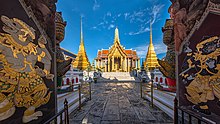
Demographics
| Year | Pop. | ±% p.a. |
|---|---|---|
| 1500 | 243,000,000 | — |
| 1700 | 436,000,000 | +0.29% |
| 1900 | 947,000,000 | +0.39% |
| 1950 | 1,402,000,000 | +0.79% |
| 1999 | 3,634,000,000 | +1.96% |
| 2016 | 4,462,676,731 | +1.22% |
| Source: "UN report 2004 data" (PDF). The figure for 2018 is provided by the 2019 revision of the World Population Prospects[2][3]. | ||

East Asia had by far the strongest overall Human Development Index (HDI) improvement of any region in the world, nearly doubling average HDI attainment over the past 40 years, according to the report's analysis of health, education and income data. China, the second highest achiever in the world in terms of HDI improvement since
1970, is the only country on the "Top 10 Movers" list due to income rather than health or education achievements. Its per capita income increased a stunning 21-fold over the last four decades, also lifting hundreds of millions out of income poverty. Yet it was not among the region's top performers in improving school enrollment and life expectancy.[79]
Nepal, a South Asian country, emerges as one of the world's fastest movers since 1970 mainly due to health and education achievements. Its present life expectancy is 25 years longer than in the 1970s. More than four of every five children of school age in Nepal now attend primary school, compared to just one in five 40 years ago.[79]
Hong Kong ranked highest among the countries grouped on the HDI (number 7 in the world, which is in the "very high human development" category), followed by Singapore (9), Japan (19) and South Korea (22). Afghanistan (155) ranked lowest amongst Asian countries out of the 169 countries assessed.[79]
Languages
Asia is home to several language families and many language isolates. Most Asian countries have more than one language that is natively spoken. For instance, according to Ethnologue, more than 600 languages are spoken in Indonesia, more than 800 languages spoken in India, and more than 100 are spoken in the Philippines. China has many languages and dialects in different provinces.
Religions
Many of the world's major religions have their origins in Asia, including the five most practiced in the world (excluding irreligion), which are Christianity, Islam, Hinduism, Chinese folk religion (classified as Confucianism and Taoism), and Buddhism respectively. Asian mythology is complex and diverse. The story of the Great Flood for example, as presented to Jews in the Hebrew Bible in the narrative of Noah—and later to Christians in the Old Testament, and to Muslims in the Quran—is earliest found in Mesopotamian mythology, in the Enûma Eliš and Epic of Gilgamesh. Hindu mythology similarly tells about an avatar of Vishnu in the form of a fish who warned Manu of a terrible flood. Ancient Chinese mythology also tells of a Great Flood spanning generations, one that required the combined efforts of emperors and divinities to control.
Abrahamic
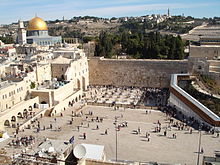

The Abrahamic religions including Judaism, Christianity, Islam and Baháʼí Faith originated in West Asia.
Judaism, the oldest of the Abrahamic faiths, is practiced primarily in Israel, the indigenous homeland and historical birthplace of the Hebrew nation: which today consists both of those Jews who remained in the Middle East and those who returned from diaspora in Europe, North America, and other regions;[80] though various diaspora communities persist worldwide. Jews are the predominant ethnic group in Israel (75.6%) numbering at about 6.1 million,[81] although the levels of adherence to Jewish religion vary. Outside of Israel there are small ancient Jewish communities in Turkey (17,400),[82] Azerbaijan (9,100),[83] Iran (8,756),[84] India (5,000) and Uzbekistan (4,000),[85] among many other places. In total, there are 14.4–17.5 million (2016, est.)[86] Jews alive in the world today, making them one of the smallest Asian minorities, at roughly 0.3 to 0.4 percent of the total population of the continent.
Christianity is a widespread religion in Asia with more than 286 million adherents according to Pew Research Center in 2010,[87] and nearly 364 million according to Britannica Book of the Year 2014.[88] Constituting around 12.6% of the total population of Asia. In the Philippines and East Timor, Roman Catholicism is the predominant religion; it was introduced by the Spaniards and the Portuguese, respectively. In Armenia and Georgia, Eastern Orthodoxy is the predominant religion. In the Middle East, such as in the Levant, Syriac Christianity (Church of the East) and Oriental Orthodoxy are prevalent minority denominations, which are both Eastern Christian sects mainly adhered to Assyrian people or Syriac Christians. Saint Thomas Christians in India trace their origins to the evangelistic activity of Thomas the Apostle in the 1st century.[89]
Islam, which originated in the Hejaz located in modern-day Saudi Arabia, is the second largest and most widely-spread religion in Asia with at least 1 billion Muslims constituting around 23.8% of the total population of Asia.[90] With 12.7% of the world Muslim population, the country currently with the largest Muslim population in the world is Indonesia, followed by Pakistan (11.5%), India (10%), Bangladesh, Iran and Turkey. Mecca, Medina and Jerusalem are the three holiest cities for Islam in all the world. The Hajj and Umrah attract large numbers of Muslim devotees from all over the world to Mecca and Medina. Iran is the largest Shi'a country.
The Baháʼí Faith originated in Asia, in Iran (Persia), and spread from there to the Ottoman Empire, Central Asia, India, and Burma during the lifetime of Bahá'u'lláh. Since the middle of the 20th century, growth has particularly occurred in other Asian countries, because Baháʼí activities in many Muslim countries has been severely suppressed by authorities. Lotus Temple is a big Baháʼí Temple in India.
Indian and East Asian religions

Almost all Asian religions have philosophical character and Asian philosophical traditions cover a large spectrum of philosophical thoughts and writings. Indian philosophy includes Hindu philosophy and Buddhist philosophy. They include elements of nonmaterial pursuits, whereas another school of thought from India, Cārvāka, preached the enjoyment of the material world. The religions of Hinduism, Buddhism, Jainism and Sikhism originated in India, South Asia. In East Asia, particularly in China and Japan, Confucianism, Taoism and Zen Buddhism took shape.
As of 2012, Hinduism has around 1.1 billion adherents. The faith represents around 25% of Asia's population and is the largest religion in Asia. However, it is mostly concentrated in South Asia. Over 80% of the populations of both India and Nepal adhere to Hinduism, alongside significant communities in Bangladesh, Pakistan, Bhutan, Sri Lanka and Bali, Indonesia. Many overseas Indians in countries such as Burma, Singapore and Malaysia also adhere to Hinduism.
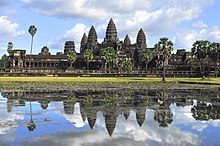
Buddhism has a great following in mainland Southeast Asia and East Asia. Buddhism is the religion of the majority of the populations of Cambodia (96%),[92] Thailand (95%),[93] Burma (80–89%),[94] Japan (36–96%),[95] Bhutan (75–84%),[96] Sri Lanka (70%),[97] Laos (60–67%)[98] and Mongolia (53–93%).[99] Large Buddhist populations also exist in Singapore (33–51%),[100] Taiwan (35–93%),[101][102][103][104] South Korea (23–50%),[105] Malaysia (19–21%),[106] Nepal (9–11%),[107] Vietnam (10–75%),[108] China (20–50%),[109] North Korea (2–14%),[110][111][112] and small communities in India and Bangladesh. The Communist-governed countries of China, Vietnam and North Korea are officially atheist, thus the number of Buddhists and other religious adherents may be under-reported.
Jainism is found mainly in India and in overseas Indian communities such as the United States and Malaysia. Sikhism is found in Northern India and amongst overseas Indian communities in other parts of Asia, especially Southeast Asia. Confucianism is found predominantly in Mainland China, South Korea, Taiwan and in overseas Chinese populations. Taoism is found mainly in Mainland China, Taiwan, Malaysia and Singapore. In many Chinese communities, Taoism is easily syncretized with Mahayana Buddhism, thus exact religious statistics are difficult to obtain and may be understated or overstated.

Japanese wedding at the Meiji Shrine

Hindu festival celebrated by Singapore's Tamil community

Bar mitzvah at the Western Wall in Jerusalem

Catholic procession of the Black Nazarene in Manila

Muslim men praying at the Ortaköy Mosque in Istanbul

Buddhist Monks performing traditional Sand mandala made from coloured sand
Modern conflicts
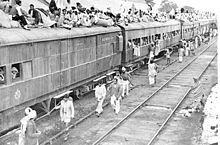


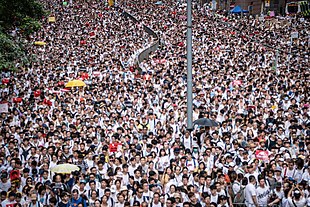
Some of the events pivotal in the Asia territory related to the relationship with the outside world in the post-Second World War were:
- The Partition of India
- The Chinese Civil War
- The Kashmir conflict
- The Balochistan Conflict
- The Naxalite–Maoist insurgency in India
- The Korean War
- The French-Indochina War
- The Vietnam War
- The Indonesia–Malaysia confrontation
- The 1959 Tibetan uprising
- The Sino-Vietnamese War
- The Bangladesh Liberation War
- The Yom Kippur War
- The Xinjiang conflict
- The Iranian Revolution
- The Soviet–Afghan War
- The Iran–Iraq War
- The Cambodian Killing Fields
- The Insurgency in Laos
- The Lebanese Civil War
- The Sri Lankan Civil War
- The 1988 Maldives coup d'état
- The Dissolution of the Soviet Union
- The Gulf War
- The Nepalese Civil War
- The Indo-Pakistani wars and conflicts
- The West Papua conflict
- The First Nagorno-Karabakh War
- The 1989 Tiananmen Square protests
- The Indonesian occupation of East Timor
- The 1999 Pakistani coup d'état
- The War in Afghanistan
- The Iraq War
- The South Thailand insurgency
- The 2006 Thai coup d'état
- The Burmese Civil War
- The Saffron Revolution
- The Kurdish-Turkish conflict
- The Arab Spring
- The Arab–Israeli conflict
- The Syrian Civil War
- The Sino-Indian War
- The 2014 Thai coup d'état
- The Moro conflict in the Philippines
- The Islamic State of Iraq and the Levant
- The Turkish invasion of Syria
- The Rohingya crisis in Myanmar
- The Saudi Arabian-led intervention in Yemen
- The Hong Kong protests
- The 2020 China–India skirmishes
Culture
This section needs expansion with: More information about general cultural topics other than Nobel prizes. You can help by . (June 2011) |
Nobel prizes

The polymath Rabindranath Tagore, a Bengali poet, dramatist, and writer from Santiniketan, now in West Bengal, India, became in 1913 the first Asian Nobel laureate. He won his Nobel Prize in Literature for notable impact his prose works and poetic thought had on English, French, and other national literatures of Europe and the Americas. He is also the writer of the national anthems of Bangladesh and India.
Other Asian writers who won Nobel Prize for literature include Yasunari Kawabata (Japan, 1968), Kenzaburō Ōe (Japan, 1994), Gao Xingjian (China, 2000), Orhan Pamuk (Turkey, 2006), and Mo Yan (China, 2012). Some may consider the American writer, Pearl S. Buck, an honorary Asian Nobel laureate, having spent considerable time in China as the daughter of missionaries, and based many of her novels, namely The Good Earth (1931) and The Mother (1933), as well as the biographies of her parents of their time in China, The Exile and Fighting Angel, all of which earned her the Literature prize in 1938.
Also, Mother Teresa of India and Shirin Ebadi of Iran were awarded the Nobel Peace Prize for their significant and pioneering efforts for democracy and human rights, especially for the rights of women and children. Ebadi is the first Iranian and the first Muslim woman to receive the prize. Another Nobel Peace Prize winner is Aung San Suu Kyi from Burma for her peaceful and non-violent struggle under a military dictatorship in Burma. She is a nonviolent pro-democracy activist and leader of the National League for Democracy in Burma (Myanmar) and a noted prisoner of conscience. She is a Buddhist and was awarded the Nobel Peace Prize in 1991. Chinese dissident Liu Xiaobo was awarded the Nobel Peace Prize for "his long and non-violent struggle for fundamental human rights in China" on 8 October 2010. He is the first Chinese citizen to be awarded a Nobel Prize of any kind while residing in China. In 2014, Kailash Satyarthi from India and Malala Yousafzai from Pakistan were awarded the Nobel Peace Prize "for their struggle against the suppression of children and young people and for the right of all children to education".
Sir C.V. Raman is the first Asian to get a Nobel prize in Sciences. He won the Nobel Prize in Physics "for his work on the scattering of light and for the discovery of the effect named after him".
Japan has won the most Nobel Prizes of any Asian nation with 24 followed by India which has won 13.
Amartya Sen, (born 3 November 1933) is an Indian economist who was awarded the 1998 Nobel Memorial Prize in Economic Sciences for his contributions to welfare economics and social choice theory, and for his interest in the problems of society's poorest members.
Other Asian Nobel Prize winners include Subrahmanyan Chandrasekhar, Abdus Salam, Malala Yousafzai, Robert Aumann, Menachem Begin, Aaron Ciechanover, Avram Hershko, Daniel Kahneman, Shimon Peres, Yitzhak Rabin, Ada Yonath, Yasser Arafat, José Ramos-Horta and Bishop Carlos Filipe Ximenes Belo of Timor Leste, Kim Dae-jung, and 13 Japanese scientists. Most of the said awardees are from Japan and Israel except for Chandrasekhar and Raman (India), Abdus Salam and Malala yousafzai, (Pakistan), Arafat (Palestinian Territories), Kim (South Korea), and Horta and Belo (Timor Leste).
In 2006, Dr. Muhammad Yunus of Bangladesh was awarded the Nobel Peace Prize for the establishment of Grameen Bank, a community development bank that lends money to poor people, especially women in Bangladesh. Dr. Yunus received his PhD in economics from Vanderbilt University, United States. He is internationally known for the concept of micro credit which allows poor and destitute people with little or no collateral to borrow money. The borrowers typically pay back money within the specified period and the incidence of default is very low.
The Dalai Lama has received approximately eighty-four awards over his spiritual and political career.[113] On 22 June 2006, he became one of only four people ever to be recognized with Honorary Citizenship by the Governor General of Canada. On 28 May 2005, he received the Christmas Humphreys Award from the Buddhist Society in the United Kingdom. Most notable was the Nobel Peace Prize, presented in Oslo, Norway on 10 December 1989.
Political geography

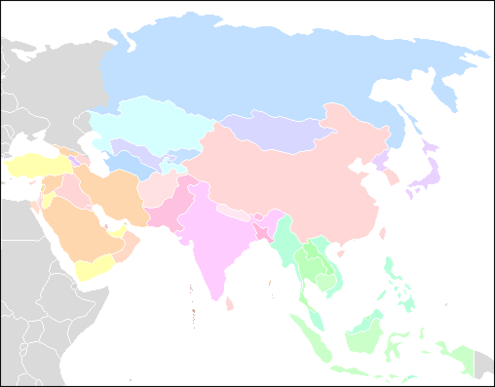
Arabia
| Flag | Symbol | Name | Population[2][3] (2018) |
Area (km2) |
Capital |
|---|---|---|---|---|---|
| Afghanistan | 37,171,921 | 647,500 | Kabul | ||
| Armenia | 2,951,745 | 29,743 | Yerevan | ||
| Azerbaijan[114] | 9,949,537 | 86,600 | Baku | ||
| Bahrain | 1,569,446 | 760 | Manama | ||
| Bangladesh | 161,376,708 | 147,570 | Dhaka | ||
| Bhutan | 754,388 | 38,394 | Thimphu | ||
| Brunei | 428,963 | 5,765 | Bandar Seri Begawan | ||
| Cambodia | 16,249,792 | 181,035 | Phnom Penh | ||
| China (PRC) | 1,427,647,786 | 9,596,961 | Beijing | ||
| Cyprus | 1,189,265 | 9,251 | Nicosia | ||
| East Timor | 1,267,974 | 14,874 | Dili | ||
| Georgia[114] | 4,002,942 | 69,700 | Tbilisi | ||
| India | 1,352,642,280 | 3,287,263 | New Delhi | ||
| Indonesia[114] | 267,670,543 | 1,904,569 | Jakarta | ||
| Iran | 81,800,188 | 1,648,195 | Tehran | ||
| Iraq | 38,433,600 | 438,317 | Baghdad | ||
| Israel | 8,381,516 | 20,770 | Jerusalem (disputed) | ||
| Japan | 127,202,192 | 377,915 | Tokyo | ||
| Jordan | 9,965,318 | 89,342 | Amman | ||
| Kazakhstan[114] | 18,319,618 | 2,724,900 | Nur-Sultan | ||
| Kuwait | 4,137,312 | 17,818 | Kuwait City | ||
| Kyrgyzstan | 6,304,030 | 199,951 | Bishkek | ||
| Laos | 7,061,507 | 236,800 | Vientiane | ||
| Lebanon | 6,859,408 | 10,400 | Beirut | ||
| Malaysia | 31,528,033 | 329,847 | Kuala Lumpur | ||
| Maldives | 515,696 | 298 | Malé | ||
| Mongolia | 3,170,216 | 1,564,116 | Ulaanbaatar | ||
| Myanmar | 53,708,320 | 676,578 | Naypyidaw | ||
| Nepal | 28,095,714 | 147,181 | Kathmandu | ||
| North Korea | 25,549,604 | 120,538 | Pyongyang | ||
| Oman | 4,829,473 | 309,500 | Muscat | ||
| Pakistan | 211,103,000 | 881,913 | Islamabad | ||
| Palestine | 4,862,979 | 6,220 | Ramallah (Jerusalem) (Disputed) | ||
| The Philippines | 106,651,394 | 343,448 | Manila | ||
| Qatar | 2,781,682 | 11,586 | Doha | ||
| Russia[115] | 145,734,038 | 17,098,242 | Moscow[116] | ||
| Saudi Arabia | 33,702,756 | 2,149,690 | Riyadh | ||
| Singapore | 5,757,499 | 697 | Singapore | ||
| South Korea | 51,171,706 | 100,210 | Seoul | ||
| Sri Lanka | 21,228,763 | 65,610 | Sri Jayawardenepura Kotte | ||
| Syria | 16,945,057 | 185,180 | Damascus | ||
| Taiwan | 23,726,460 | 36,193 | Taipei | ||
| Tajikistan | 9,100,835 | 143,100 | Dushanbe | ||
| Thailand | 69,428,453 | 513,120 | Bangkok | ||
| Turkey[117] | 82,340,088 | 783,562 | Ankara | ||
| Turkmenistan | 5,850,901 | 488,100 | Ashgabat | ||
| United Arab Emirates | 9,630,959 | 83,600 | Abu Dhabi | ||
| Uzbekistan | 32,476,244 | 447,400 | Tashkent | ||
| Vietnam | 95,545,962 | 331,212 | Hanoi | ||
| Yemen | 28,498,683 | 527,968 | Sana'a |
Within the above-mentioned states are several partially recognized countries with limited to no international recognition. None of them are members of the UN:
| Flag | Symbol | Name | Population |
Area (km2) |
Capital |
|---|---|---|---|---|---|
| Abkhazia | 242,862 | 8,660 | Sukhumi | ||
| Artsakh | 146,573 | 11,458 | Stepanakert | ||
| Northern Cyprus | 326,000 | 3,355 | North Nicosia | ||
| South Ossetia | 51,547 | 3,900 | Tskhinvali |
See also
References to articles:
- Subregions of Asia
Special topics:
- Asian Century
- Asian cuisine
- Asian furniture
- Asian Games
- Asia-Pacific
- Asian Para Games
- Asian Monetary Unit
- Asian people
- Eastern world
- Eurasia
- Far East
- East Asia
- Southeast Asia
- South Asia
- Central Asia
- Western Asia
- North Asia
- Fauna of Asia
- Flags of Asia
- Middle East
- Eastern Mediterranean
- Levant
- Near East
- Pan-Asianism
Lists:
- List of cities in Asia
- List of metropolitan areas in Asia by population
- List of sovereign states and dependent territories in Asia
Projects
- Asian Highway Network
- Trans-Asian Railway
Notes
- ^ Siberia lies in Asia geographically, but is considered a part of Europe culturally and politically.
References
- ^ National Geographic Family Reference Atlas of the World. Washington, DC: National Geographic Society (U.S.). 2006. p. 264.
- ^ Jump up to: a b c ""World Population prospects – Population division"". population.un.org. United Nations Department of Economic and Social Affairs, Population Division. Retrieved 9 November 2019.
- ^ Jump up to: a b c ""Overall total population" – World Population Prospects: The 2019 Revision" (xslx). population.un.org (custom data acquired via website). United Nations Department of Economic and Social Affairs, Population Division. Retrieved 9 November 2019.
- ^ "GDP PPP, current prices". International Monetary Fund. 2021. Retrieved 16 January 2021.
- ^ "GDP Nominal, current prices". International Monetary Fund. 2021. Retrieved 16 January 2021.
- ^ "Nominal GDP per capita". International Monetary Fund. 2021. Retrieved 16 January 2021.
- ^ "The World at Six Billion". UN Population Division. Archived from the original on 5 March 2016., Table 2
- ^ "Population of Asia. 2019 demographics: density, ratios, growth rate, clock, rate of men to women". www.populationof.net. Retrieved 2 June 2019.
- ^ Jump up to: a b National Geographic Atlas of the World (7th ed.). Washington, D.C.: National Geographic. 1999. ISBN 978-0-7922-7528-2. "Europe" (pp. 68–69); "Asia" (pp. 90–91): "A commonly accepted division between Asia and Europe is formed by the Ural Mountains, Ural River, Caspian Sea, Caucasus Mountains, and the Black Sea with its outlets, the Bosporus and Dardanelles."
- ^ Nalapat, M. D. "Ensuring China's 'Peaceful Rise'". Archived from the original on 10 January 2010. Retrieved 22 January 2016.
- ^ Dahlman, Carl J; Aubert, Jean-Eric. China and the Knowledge Economy: Seizing the 21st Century. WBI Development Studies. World Bank Publications. Accessed January 22, 2016. Eric.ed.gov. World Bank Publications. 2000. ISBN 978-0-8213-5005-8. Archived from the original on 4 March 2008. Retrieved 9 November 2017.
- ^ "The Real Great Leap Forward". The Economist. 30 September 2004. Archived from the original on 27 December 2016.
- ^ [1] Archived 20 November 2008 at the Wayback Machine
- ^ "Like herrings in a barrel". The Economist (Millennium issue: Population). 23 December 1999. Archived from the original on 4 January 2010..
- ^ "Suez Canal: 1250 to 1920: Middle East", Cultural Sociology of the Middle East, Asia, & Africa: An Encyclopedia, SAGE Publications, Inc., 2012, doi:10.4135/9781452218458.n112, ISBN 978-1-4129-8176-7, S2CID 126449508
- ^ Histories 4.38. C.f. James Rennell, The Geographical System of Herodotus Examined and Explained, Volume 1, Rivington 1830, p. 244
- ^ according to Strabo (Geographica 11.7.4) even at the time of Alexander, "it was agreed by all that the Tanais river separated Asia from Europe" (ὡμολόγητο ἐκ πάντων ὅτι διείργει τὴν Ἀσίαν ἀπὸ τῆς Εὐρώπης ὁ Τάναϊς ποταμός; c.f. Duane W. Roller, Eratosthenes' Geography, Princeton University Press, 2010, ISBN 978-0-691-14267-8, p. 57)
- ^ W. Theiler, Posidonios. Die Fragmente, vol. 1. Berlin: De Gruyter, 1982, fragm. 47a.
- ^ I. G. Kidd (ed.), Posidonius: The commentary, Cambridge University Press, 2004, ISBN 978-0-521-60443-7, p. 738.
- ^ Geographia 7.5.6 (ed. Nobbe 1845, vol. 2, p. 178) Καὶ τῇ Εὐρώπῃ δὲ συνάπτει διὰ τοῦ μεταξὺ αὐχένος τῆς τε Μαιώτιδος λίμνης καὶ τοῦ Σαρματικοῦ Ὠκεανοῦ ἐπὶ τῆς διαβάσεως τοῦ Τανάϊδος ποταμοῦ. "And [Asia] is connected to Europe by the land-strait between Lake Maiotis and the Sarmatian Ocean where the river Tanais crosses through."
- ^ Jump up to: a b Lineback, Neal (9 July 2013). "Geography in the News: Eurasia's Boundaries". National Geographic. Archived from the original on 8 May 2016. Retrieved 9 June 2016.
- ^ Lewis & Wigen 1997, pp. 27–28
- ^ Lewis & Wigen 1997, pp. 170–173
- ^ Lewis & Wigen 1997, pp. 7–9
- ^ "Asia". AccessScience. McGraw-Hill. Archived from the original on 27 November 2011. Retrieved 26 July 2011.
- ^ Schwartz, Benjamin (December 2008). "Geography Is Destiny". The Atlantic. Archived from the original on 30 September 2009.
- ^ Jump up to: a b c d e Reid, T.R. Confucius Lives Next Door: What living in the East teaches us about living in the west Vintage Books(1999).
- ^ "Asia – Origin and meaning of Asia by Online Etymology Dictionary". Etymonline.com. Archived from the original on 25 May 2017. Retrieved 9 November 2017.
- ^ Ventris & Chadwick 1973, p. 536.
- ^ Ventris & Chadwick 1973, p. 410
- ^ Bossert, Helmut T., Asia, Istanbul, 1946.
- ^ Henry George Liddell; Robert Scott; Henry Stuart Jones; Roderick McKenzie (2007) [1940]. "Ἀσία". A Greek-English Lexicon. Medford: Perseus Digital Library, Tufts University. Archived from the original on 27 April 2011.
- ^ Book IV, Articles 37–40.
- ^ Book IV, Article 45.
- ^ "Asie". Encyclopedia: Greek Gods, Spirits, Monsters. Theoi Greek Mythology, Exploring Mythology in Classical Literature and Art. 2000–2011. Archived from the original on 4 June 2010.
- ^ Theogony, Line 345 ff.
- ^ Theogony, Line 364ff.
- ^ Μ95, Π717.
- ^ Β461.
- ^ Muhmmad al-Bukhari. Sahih Al-Bukhari Translated into English Prose by Muhammad Muhsin Khan. Hadith 7.329
- ^ Silkroad Foundation, Adela C.Y. Lee. "Ancient Silk Road Travellers". Silk-road.com. Archived from the original on 8 November 2017. Retrieved 9 November 2017.
- ^ Ping-ti Ho. "An Estimate of the Total Population of Sung-Chin China", in Études Song, Series 1, No 1, (1970). pp. 33–53.
- ^ "History – Black Death". BBC. 17 February 2011. Archived from the original on 5 June 2012.
- ^ Sen, Sailendra Nath (2010). An Advanced History of Modern India. p. 11. ISBN 978-0-230-32885-3. Archived from the original on 11 October 2017.
- ^ "A Map of the Countries between Constantinople and Calcutta: Including Turkey in Asia, Persia, Afghanistan and Turkestan". Wdl.org. 1885. Archived from the original on 17 October 2017. Retrieved 9 November 2017.
- ^ "Asia". Encyclopædia Britannica Online. Chicago: Encyclopædia Britannica, Inc. 2006. Archived from the original on 18 November 2008.
- ^ "Standard Country or Area Codes for Statistical Use (M49 Standard)". UN Statistica Division. "Geographic Regions" anklicken Zitat: "The assignment of countries or areas to specific groupings is for statistical convenience and does not imply any assumption regarding political or other affiliation of countries or territories by the United Nations."
- ^ "Asia tops climate change's 'most vulnerable' list". New Scientist. Retrieved 17 December 2020.
- ^ "Which countries are most threatened by and vulnerable to climate change?". Iberdrola. Retrieved 17 December 2020.
- ^ "Global Climate Risk Index 2020 - World". ReliefWeb. Retrieved 17 December 2020.
- ^ Vulnerability to Climate Change: Adaptation Strategies and layers of Resilience Archived 26 February 2014 at the Wayback Machine, ICRISAT, Policy Brief No. 23, February 2013
- ^ Overland, Indra; Sagbakken, Haakon Fossum; Chan, Hoy-Yen; Merdekawati, Monika; Suryadi, Beni; Utama, Nuki Agya; Vakulchuk, Roman (December 2021). "The ASEAN climate and energy paradox". Energy and Climate Change. 2: 100019. doi:10.1016/j.egycc.2020.100019. hdl:11250/2734506.
- ^ "World Economic Outlook (October 2018) – GDP, current prices". www.imf.org.
- ^ "Largest_Economies_in_Asia". Aneki.com. Retrieved 9 November 2017.
- ^ "Hong Kong, Singapore, Tokyo World's Top Office Destinations". CFO innovation ASIA. Archived from the original on 7 August 2011. Retrieved 21 July 2011.
- ^ Farah, Paolo Davide (4 August 2006). "Five Years of China WTO Membership: EU and US Perspectives About China's Compliance With Transparency Commitments and the Transitional Review Mechanism". SSRN 916768. Cite journal requires
|journal=(help) - ^ Maddison, Angus (20 September 2007). Contours of the World Economy 1-2030 AD: Essays in Macro-Economic History. ISBN 978-0-19-164758-1.
- ^ Angus, Maddison (25 September 2003). Development Centre Studies the World Economy Historical Statistics: Historical Statistics. ISBN 9789264104143.
- ^ Bairoch, Paul (1995). Economics and world history : Myths and paradoxes. ISBN 9780226034638.
- ^ http://www.theworldeconomy.org/MaddisonTables/MaddisontableB-18.pdf
- ^ Professor M.D. Nalapat (11 September 2001). "Ensuring China's "Peaceful Rise"". Bharat-rakshak.com. Archived from the original on 10 January 2010. Retrieved 1 June 2010.
- ^ Dahlman, Carl J; Aubert, Jean-Eric. China and the Knowledge Economy: Seizing the 21st century. WBI Development Studies. World Bank Publications. Accessed 30 January 2008. Eric.ed.gov. 2000. ISBN 978-0-8213-5005-8. Archived from the original on 4 March 2008. Retrieved 1 June 2010.
- ^ "The Real Great Leap Forward". The Economist. 30 September 2004. Archived from the original on 27 December 2016. Retrieved 1 June 2010.
- ^ Fagoyinbo B, Joseph (2013). The Armed Forces: Instrument of Peace, Strength, Development and Prosperity. AuthorHouse UK. p. 58. ISBN 978-1-4772-1844-0.
- ^ "Rise of Japan and 4 Asian Tigers from". emergingdragon.com. Archived from the original on 22 April 2010. Retrieved 1 June 2010.
- ^ "Commonwealth Business Council-Asia". Archived from the original on 28 July 2007. Retrieved 12 April 2007.
- ^ "Philippine potential cited". sme.com.ph. 24 February 2011. Archived from the original on 24 April 2011. Retrieved 1 March 2011.
- ^ Estimated containerized cargo flows on major container trade routes in 2020, by trade route
- ^ Global Marine Trends 2030 Report
- ^ Maritime Trade
- ^ Harry G. Broadman "Afrika's Silk Road" (2007), pp 59.
- ^ Harry de Wilt: Is One Belt, One Road a China crisis for North Sea main ports? in World Cargo News, 17. December 2019.
- ^ Bernhard Simon: Can The New Silk Road Compete With The Maritime Silk Road? in The Maritime Executive, 1 January 2020.
- ^ Jean-Marc F. Blanchard "China's Maritime Silk Road Initiative and South Asia" (2018).
- ^ INTRA-ASIA
- ^ "Asia has more millionaires than Europe". Toronto. Archived from the original on 25 June 2011.
- ^ Vallikappen, Sanat (28 March 2012). "Citigroup Study Shows Asian Rich Topping North American". Bloomberg. Archived from the original on 14 January 2015.
- ^ "Milan and Rome named among the most widely visited cities in the world in the Mastercard Global Destination Cities Index report". Italianavenue.com. 28 May 2013. Archived from the original on 17 October 2017. Retrieved 9 November 2017.
- ^ Jump up to: a b c "2010 Human Development Report: Asian countries lead development progress over 40 years" (PDF). UNDP. Archived (PDF) from the original on 21 November 2010. Retrieved 22 December 2010.
- ^ "The Jewish Population of the World". Jewishvirtuallibrary.org. Archived from the original on 21 June 2010. Retrieved 1 June 2010.
- ^ Ettinger, Yoram (5 April 2013). "Defying demographic projections". Israel Hayom. Archived from the original on 29 October 2013. Retrieved 29 October 2013.
- ^ "Turkey Virtual Jewish History Tour | Jewish Virtual Library". jewishvirtuallibrary.org. Archived from the original on 11 October 2014. Retrieved 15 December 2014.
- ^ "Ethnic composition of Azerbaijan 2009". Pop-stat.mashke.org. 7 April 1971. Archived from the original on 7 February 2012. Retrieved 22 December 2012.
- ^ "Jewish woman brutally murdered in Iran over property dispute". The Times of Israel. 28 November 2012. Archived from the original on 19 August 2014. Retrieved 16 August 2014.
A government census published earlier this year indicated there were a mere 8,756 Jews left in Iran
See Persian Jews#Iran - ^ World Jewish Population 2007 Archived 26 March 2009 at the Wayback Machine, American Jewish Yearbook, vol. 107 (2007), p. 592.
- ^ "World Jewish Population 2016 (DellaPergola, AJYB) | Berman Jewish DataBank". jewishdatabank.org. Retrieved 24 March 2018.
- ^ "Christians". Pew Research Center's Religion & Public Life Project. 18 December 2012. Archived from the original on 10 March 2015. Retrieved 13 March 2015.
- ^ Encyclopaedia Britannica, Inc (2014). Britannica Book of the Year 2014. ISBN 978-1-62513-171-3. Archived from the original on 29 April 2016. Retrieved 13 March 2015.
- ^ The Encyclopedia of Christianity, Volume 5 by Erwin Fahlbusch. Wm. B. Eerdmans Publishing. 2008, p. 285. ISBN 978-0-8028-2417-2.
- ^ "Region: Asia-Pacific". Pewforum.org. 27 January 2011. Archived from the original on 10 October 2017. Retrieved 9 November 2017.
- ^ Jha, Preeti (26 December 2007). "Guinness comes to east Delhi: Akshardham world's largest Hindu temple". ExpressIndia.com. Archived from the original on 28 December 2007. Retrieved 2 January 2008.
- ^ "The World Factbook". Cia.gov. Retrieved 20 December 2010.
- ^ "CIA – The World Factbook". Cia.gov. Retrieved 20 December 2010.
- ^ "The World Factbook". Cia.gov. Retrieved 20 December 2010.
- ^ "The World Factbook". Cia.gov. Retrieved 20 December 2010.
- ^ "The World Factbook". Cia.gov. Retrieved 20 December 2010.
- ^ "The Census of Population and Housing of Sri Lanka-2011". Department of Census and Statistics. Archived from the original on 24 July 2013. Retrieved 29 July 2013.
- ^ "The World Factbook". Cia.gov. Retrieved 20 December 2010.
- ^ "The World Factbook". Cia.gov. Retrieved 20 December 2010.
- ^ "The World Factbook". Cia.gov. Retrieved 20 December 2010.
- ^ "The World Factbook". Cia.gov. Retrieved 20 December 2010.
- ^ "China (includes Taiwan only): International Religious Freedom Report 2005". US Department of State: Bureau of Democracy, Human Rights, and Labor. 8 November 2005. Retrieved 24 January 2008.
- ^ "China (includes Taiwan only): International Religious Freedom Report 2006". US Department of State: Bureau of Democracy, Human Rights, and Labor. 15 September 2006. Retrieved 24 February 2008.
- ^ "China (includes Taiwan only): International Religious Freedom Report 2007". US Department of State: Bureau of Democracy, Human Rights, and Labor. 15 September 2006. Retrieved 24 February 2008.
- ^ "CThe World Factbook". Cia.gov. Retrieved 20 December 2010.
- ^ "The World Factbook". Cia.gov. Retrieved 20 December 2010.
- ^ "The World Factbook". Cia.gov. Retrieved 20 December 2010.
- ^ "The World Factbook". Cia.gov. Retrieved 20 December 2010.
- ^ "Chinese Han Nationality: Language, Religion, Customs". Travelchinaguide.com. Archived from the original on 17 October 2017. Retrieved 9 November 2017.
- ^ "Culture of North Korea – Alternative name, History and ethnic relations". Countries and Their Cultures. Advameg Inc. Archived from the original on 5 August 2009. Retrieved 4 July 2009.
- ^ "The World Factbook". Cia.gov. Retrieved 9 November 2017.
- ^ Bureau of East Asian and Pacific Affairs (2009). "Background Note: North Korea". U.S. State Department. Retrieved 4 July 2009.
- ^ His Holiness's Teachings at TCV. "A Brief Biography – The Office of His Holiness The Dalai Lama". Dalailama.com. Archived from the original on 25 May 2010. Retrieved 1 June 2010.
- ^ Jump up to: a b c d transcontinental country.
- ^ Russia is a transcontinental country located in Eastern Europe and Northern Asia, but is considered European historically, culturally, ethnically, and politically, and the vast majority of its population (78%) lives within its European part.
- ^ Moscow is located in Europe.
- ^ Turkey is a transcontinental country located mainly in Western Asia with a smaller portion in Southeastern Europe.
Bibliography
- Lewis, Martin W.; Wigen, Kären (1997). The myth of continents: a critique of metageography. Berkeley and Los Angeles: University of California Press. ISBN 978-0-520-20743-1.
- Ventris, Michael; Chadwick, John (1973). Documents in Mycenaean Greek (2nd ed.). Cambridge: University Press.
Further reading
- Embree, Ainslie T., ed. Encyclopedia of Asian history (1988)
- Higham, Charles. Encyclopedia of Ancient Asian Civilizations. Facts on File library of world history. New York: Facts On File, 2004.
- Kamal, Niraj. "Arise Asia: Respond to White Peril". New Delhi: Wordsmith, 2002, ISBN 978-81-87412-08-3
- Kapadia, Feroz, and Mandira Mukherjee. Encyclopaedia of Asian Culture and Society. New Delhi: Anmol Publications, 1999.
- Levinson, David, and Karen Christensen, eds. Encyclopedia of Modern Asia. (6 vol. Charles Scribner's Sons, 2002).
External links
- "Display Maps". The Soil Maps of Asia. European Digital Archive of Soil Maps – EuDASM. Archived from the original on 12 August 2011. Retrieved 26 July 2011.
- "Asia Maps". Perry–Castañeda Library Map Collection. University of Texas Libraries. Archived from the original on 18 July 2011. Retrieved 20 July 2011.
- "Asia". Norman B. Leventhal Map Center at the Boston Public Library. Archived from the original on 29 September 2011. Retrieved 26 July 2011.
- Bowring, Philip (12 February 1987). "What is Asia?". Eastern Economic Review. 135 (7). Archived from the original on 28 July 2011. Retrieved 22 April 2009.
- Asia
- Continents





























